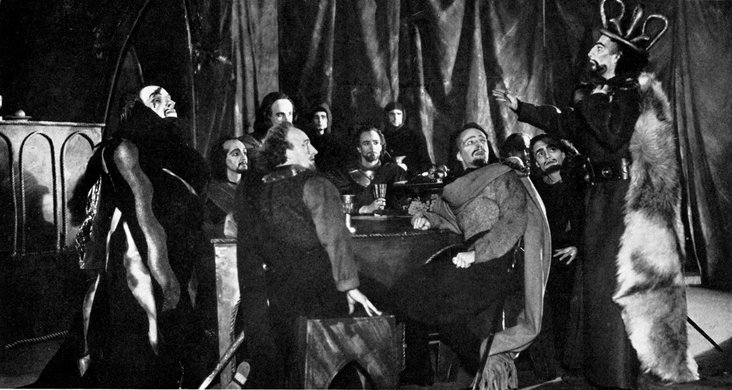OTD in early British television: 10 December 1937

John Wyver writes: this day in early British television might be celebrated for the Thursday afternoon in 1936 which featured the first relay of a sound broadcast on the Alexandra Palace service. At 15.59 that day the National Programme announcement was carried of the abdication of King Edward VIII. But I’ve chosen to focus on the troubles a year earlier of an earlier, fictional king, Macbeth. The Friday afternoon of 10 December 1937 saw the broadcast of Scenes from Macbeth, a brief transfer from the Old Vic of part of Michel Saint-Denis’ production with Laurence Olivier and Judith Anderson (above).
I have written about this broadcast before, for the Screen Plays blog just about exactly a decade ago, so forgive if I repeat some of my text from there. This production of the Scottish play at the Old Vic on 23 November. Earlier that year Olivier had played Hamlet and Henry V for the company as well as Sir Toby Belch in Twelfth Night, and he was still to take on the role of Iago to Ralph Richardson’s Othello.
Macbeth had settings and costumes by the design team known as Motley and incidental music for the production was composed by Darius Milhaud. It was clearly a significant event in the theatre season, not least because the Queen attended a matinee performance on 29 November. Theatrical lore has it that the curse of the play nearly struck when a heavy weight dropped from the flies and almost killed Olivier. Sadly, the indefatigible founder of the Old Vic, Lilian Baylis, died two days after the opening night, and this caused a delay of a week to the visit to AP.
The theatre reviewer for The Times celebrated the staging as ‘lucid’ while recognising that its ‘outstanding merit’ was Olivier’s performance, of which the critic wrote:
Sometimes still he misses the full music of Shakesperian [sic] verse, but his speaking has gained in rhythm and strength, and his attack upon the part itself, his nervous intensity, his dignity of movement and swiftness of thought, above all his tracing of the process of deterioration in a man not naturally evil give to his performance a rare consistency and power. (Anon., ‘Old Vic’, The Times, 27 November, p. 10)
Two weeks after the opening, members of the company made the journey up the hill to AP to play scenes from their staging in Studio A. It is clear from a television review in The Times that the broadcast included at least one of the scenes with the witches, Lady Macbeth reading her husband’s letter in Act I Scene 5, the exchange with his wife before Macbeth goes off to murder Duncan, and the appearance of Banquo’s ghost at the banquet.
The Times‘ television reviewer, anonymous as all cultural contributors to the Thunderer were in those days, was astute in pointing out the advantages that television had over the staging in the theatre:
The weird sisters […] were able to use the resources of the television camera in order to vanish in a most convincing way. Banquo’s ghost, too, was more effective than in the stage production, for, instead of a masked effigy, the real Banquo was there, and then he faded away, leaving Macbeth staring at the spot where he had been. (Anon., ‘Broadcasting: Televised Drama’, The Times, 13 December 1937, p. 18)
At the same time the article acknowledged how the technical limitations of the television image at a point when regular broadcasts had been established only just over a year previously:
Few of the characters [around the table] were shown on the screen at the same time, and there was no complete picture of the banquet.
The intimate nature of early television ensured that it was the duologue exchanges between the murderous couple that were most successful. But the key problem for the reviewer of this stage-to-screen translation was one which remains a concern in all discussions of multi-camera presentations of staged plays:
Mr Laurence Olivier and Miss Judith Anderson [as Lady Macbeth] were also extremely effective, though they made no attempt to moderate their voices to television scale, and still spoke to the utmost recesses of an imaginary theatre, whereas their smallest whispers would have been heard by the unseen audience. The conventions of the theatre must be got rid of if television is to stand on its own [emphasis added].
Here then, right at the start of the medium, is the prescription – which continued to be widely believed, arguably up to today – that television ‘to stand on its own’ must be liberated from its theatrical influences.
Image of the production licenced from Alamy.
Leave a Reply